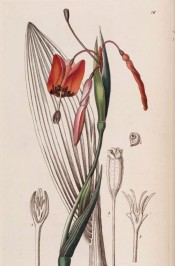Rigidella flammea Lindl.
Bulbous perennial with lance-shaped basal leaves, to 30cm long, and semi-pendant, iris-like scarlet flowers, to 10cm across, with purple markings at the base of the petals. The flowers are borne in succession before the leaves in spring or summer. To 1.5m. [RHSE, Hortus].
Horticultural & Botanical History
‘This very pretty plant was found by Mr. Hartweg in the earlier of his excursions in Mexico, and was by him sent to the Horticultural Society, where it proves to be of easy cultivation, requiring exactly the same treatment as a Tigridia. It grows from three to five feet high, with broad equitant strongly plaited leaves, which are dilated at the base where they sheath the stem. The flowers grow in a dense umbel from within a two-valved spathe, and open singly day by day; they are drooping, and of a bright flame colour, with a companulate tube, and a reflexed limb strongly marked at the base with short deep purple stripes. After flowering, the stalks, which are long and slender, become erect, and so rigid as to bear the seed vessel perfectly erect, even when gravid with seeds; from which circumstance the generic name has been contrived.
Upon submitting the drawing to the Hon. and Rev. Wm. Herbert, who is now making this subject his peculiar study, that gentleman favoured me with a note, of which the following is an extract.
“Rigidella flammea appears to me to be a very singular plant, widely removed from any known genus. Its capsule conforms closely with that of Tigridia, though the seed is different; and in the structure of its stamina and style it approaches that genus, but differs from all the uncrested genera I have observed in having an anterior space at the point where the stigma-lobes diverge. This anterior space, which by the drawing appears to be entire, and not divided or eroded in conformity with the lobes, occupies nearly the position (though placed rather higher) of the true stigma in the genera, which, like Iris, Marica, and Cypella, have posterior crests. The perianth is no less remarkable, being as it seems tubeless, and consisting of three sepals with reflex laminae, of which the ungues appear to be strangely convolute, and the petals absolutely deficient. We are accustomed to the diminution and distortion of the three petals in some of the Cape Iridaceae, to their being nearly deficient in Iris tridentata, and
reduced to a mere bristle in I. setosa, which is brachycuspis of Bot. Mag., but I know no instance of their being absolutely deficient.”
At present the plant is exceedingly rare, but as a few seeds were ripened last year in the Horticultural Society garden, it is to be hoped that plants will be ready in the course of the summer to give to the Fellows of the Society.’ [BR f.16/1840]. Introduced to Britain in 1839. [JD]. FS t.46/1845.
History at Camden Park
Rigidella flammea is listed in the 1845 and 1850 catalogues only.
Notes
Published Oct 19, 2009 - 03:17 PM | Last updated Jul 24, 2010 - 05:09 PM
| Family | Iridaceae |
|---|---|
| Category | |
| Region of origin | Mexico |
| Synonyms |
|
| Common Name | |
| Name in the Camden Park Record | Rigidella flammea |
| Confidence level | high |


